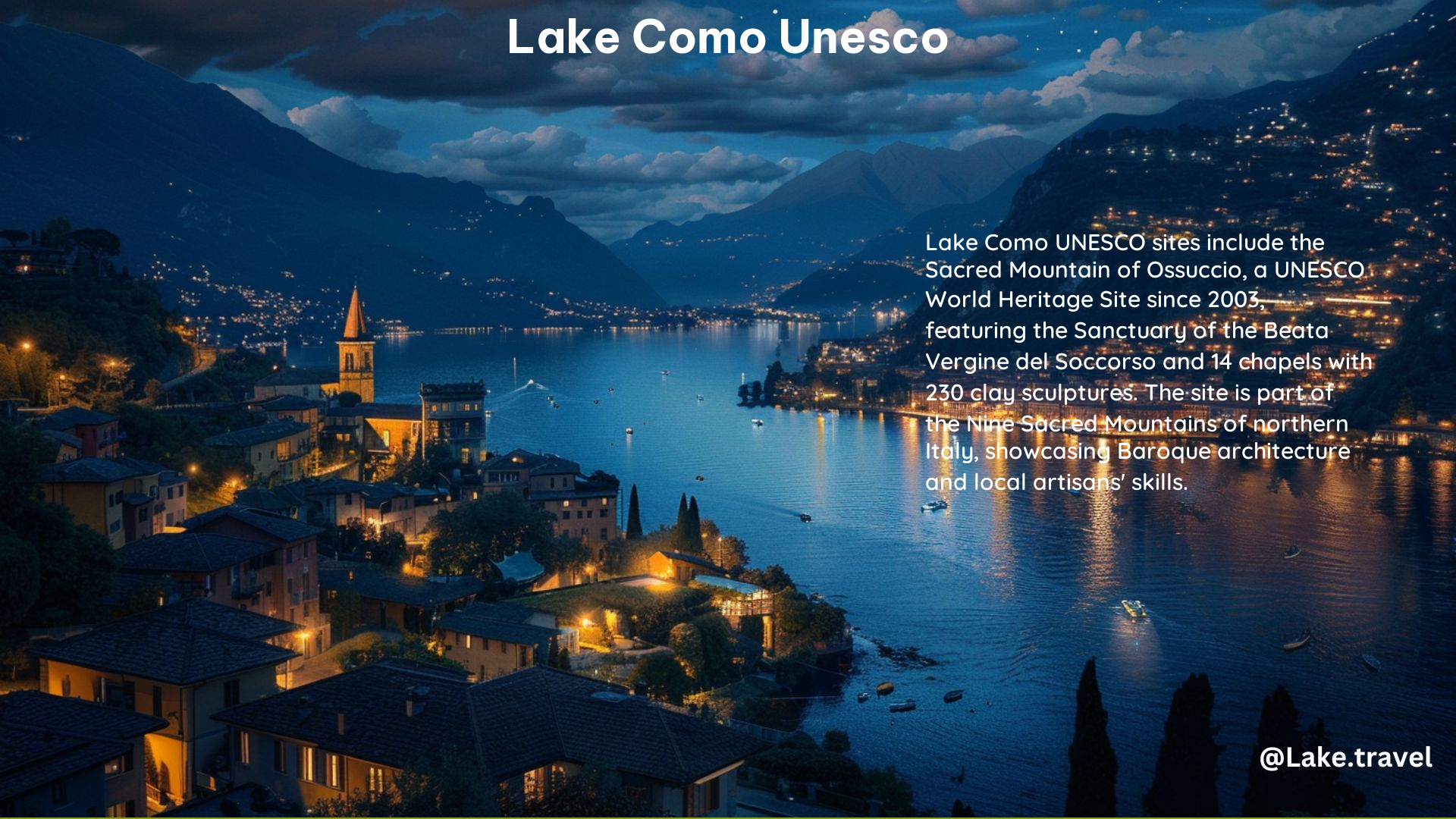Lake Como, nestled in the heart of the Italian Alps, is a breathtaking destination that boasts a rich cultural heritage and natural beauty. This picturesque region is home to several UNESCO World Heritage Sites, offering visitors a unique opportunity to immerse themselves in the history, art, and architecture of this stunning landscape.
Santuario del Soccorso (Sanctuary of Relief)
One of the UNESCO-recognized sites in the Lake Como region is the Santuario del Soccorso, located in the charming town of Ossuccio. This sanctuary, built between 1635 and 1710, is a remarkable example of Baroque architecture and a testament to the region’s deep-rooted religious traditions.
Key Features of the Santuario del Soccorso
- 14 chapels representing the Mysteries of the Rosary, each adorned with stunning stucco and terracotta statues
- 230 statues created by local artisans, showcasing the region’s rich artistic heritage
- Breathtaking views of Lake Como, adding to the sanctuary’s serene and peaceful atmosphere
Accessibility and Visitor Information
- The sanctuary is accessible by car, bus, or boat, but the final stretch to the site must be walked (approximately 1 km, 30 minutes at a leisurely pace)
- Contact information: (+39) 034 455 211
Other UNESCO Sites in the Lake Como Region

While the Santuario del Soccorso is a standout attraction, the Lake Como region is home to several other UNESCO World Heritage Sites that are worth exploring:
Santa Maria delle Grazie, Milan
- A church and Dominican convent in Milan, famous for housing Leonardo da Vinci’s masterpiece, “The Last Supper”
Venice and its Lagoon
- A UNESCO site located about 90 miles from Lake Como, accessible by train
City of Verona
- Known for its romantic atmosphere and ancient Roman monuments, such as the Verona Arena
Sacri Monti of Piedmont and Lombardy
- A group of nine chapels and architectural features, including the Sacred Mountain of Ossuccio
These UNESCO sites offer visitors a unique blend of art, history, and natural beauty, making the Lake Como region an ideal destination for those interested in cultural and lakeside tourism.
Exploring the Sacred Mountain of Ossuccio
One of the most captivating UNESCO sites in the Lake Como region is the Sacred Mountain of Ossuccio, part of the Sacri Monti of Piedmont and Lombardy. This sacred site features a series of 14 chapels, each dedicated to a different mystery of the rosary, and is surrounded by stunning natural landscapes.
Key Highlights of the Sacred Mountain of Ossuccio
- 14 chapels built between the 16th and 18th centuries, showcasing Baroque and Renaissance architectural styles
- Intricate stucco and terracotta statues adorning the chapels, created by local artisans
- Panoramic views of Lake Como and the surrounding Alps, creating a serene and spiritual atmosphere
Accessibility and Visitor Information
- The Sacred Mountain of Ossuccio is accessible by car, bus, or boat, with a final stretch of approximately 1 km to be walked
- Visitors can explore the site at their own pace, taking in the stunning views and architectural details
Discovering the Dry-stone Walls and Vineyards of Lake Como
In addition to its UNESCO-recognized sites, the Lake Como region is also renowned for its traditional dry-stone walls and vineyards, which have been recognized by UNESCO for their cultural and environmental significance.
Dry-stone Walls of Lake Como
- These walls, built without the use of mortar, have been used for centuries to terrace the steep slopes and create arable land
- The dry-stone walls are a testament to the ingenuity and hard work of the local people, who have adapted to the challenging terrain
- UNESCO has recognized the dry-stone walls of Lake Como as a unique cultural landscape, worthy of preservation
Vineyards of Lake Como
- The Lake Como region is home to a thriving wine industry, with vineyards that have been cultivated for generations
- The combination of the region’s microclimate, soil, and traditional winemaking techniques has resulted in the production of high-quality wines, such as the renowned Nebbiolo and Barbera varietals
- UNESCO has recognized the cultural and environmental significance of the Lake Como vineyards, which are an integral part of the region’s landscape and heritage
Conclusion
Lake Como’s UNESCO World Heritage Sites and cultural landscapes offer visitors a unique opportunity to explore the rich history, art, and natural beauty of this stunning region. From the Santuario del Soccorso to the Sacred Mountain of Ossuccio, and the traditional dry-stone walls and vineyards, there is something for everyone to discover and appreciate in this remarkable corner of Italy.
References:
– Viator. (n.d.). Lake Como & UNESCO Dry-stone Walls Vineyards. Retrieved from https://www.viator.com/tours/Milan/Lake-Como-and-UNESCO-dry-stone-walls-Vineyards/d512-7427P6
– Aria Journeys. (n.d.). Italian Lakes UNESCO sites. Retrieved from https://ariajourneys.com/guide/italian-lakes-unesco-sites/
– Hotel Posta. (n.d.). The “Santuario del Soccorso” in Ossuccio: an UNESCO Heritage site. Retrieved from https://blog.hotel-posta.it/en/santuario-del-soccorso-ossuccio/
– Summer In Italy. (n.d.). Sacro Monte di Ossuccio – Lake Como. Retrieved from https://www.summerinitaly.com/guide/sacro-monte-di-ossuccio
– My Lake Como. (n.d.). The Sacred Mountain of Ossuccio, UNESCO World Heritage Site. Retrieved from https://mylakecomo.co/en/attractions/sacred-mountain-ossuccio/
